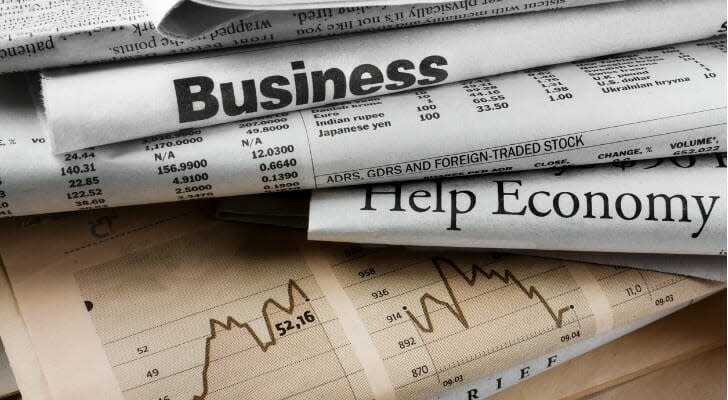Can You Learn to ‘Trade the News’?
News events can have an impact on the price of individual securities, as well as on market sectors and the stock market as a whole. This creates an opportunity for investors. The practice of managing your portfolio in response to (or in anticipation of) specific events is known as “trading the news.” If you take an active approach to investing, it may be a good idea to incorporate trading the news into your overall investment strategy. Here’s an introduction to the practice.
What Does it Mean to ‘Trade the News’?
Trading the news is an investment strategy that investors use to trade equities, currencies and other securities on financial markets. News reports that cover the economy, business and political landscape often stimulate short-term market movement. This movement within the market can create investment opportunities for investors who are paying close attention.
For instance, announcements about corporate profits and rumors about mergers and acquisitions or management changes can move share prices. News about interest rates, Federal Reserve policy swifts or unemployment rates can affect exchange rates.
Why Investors Use this Investment Strategy
Since most markets aren’t instantaneously efficient, there is room for investors to capitalize on the lag time it takes for the market to reflect on a news release. If an investor has a huge position, they may not be able to completely unwind the position when the announcement is released. This can cause them to lose faith in their trade. However, instead of losing faith, the investor should slowly uncoil their position so that they avoid the large trade from further intensifying the price movement. Therefore, this can cause buy and sell pressure to linger a while after the news breaks.
Understanding that markets may continue to move well after a news release allows you to capitalize on the occurrence. But, it’s wise to set parameters for your news trading so you don’t fall victim to so-called “news traps”.
Examples of Trading the News
Here are a few examples of how you can trade the news.
Earnings Reports
When it comes to earning reports, it’s wise to have a strategy in place before any earnings announcement. This is because investors may see extreme swings to the stock price right after the announcement, as opposed to the swings in the index once the data is available.
While it isn’t necessary to keep tabs on every earnings report in a portfolio, you may want to do so if you hold a substantially large position in one security (long or short). In this case, investors should weigh the pros and cons of leaving this position or making changes before the company releases its earnings report. Some factors you may want to consider include:
The valuation of the shares
The current state of the economy
Earning expectations
Recent performance evaluations
Investor sentiment for the specific market sector
Additionally, even if investors don’t have a large stock position in their portfolio, they may want to make moves if they have a high degree of conviction about the movement of the shares. Keep in mind, you should try to avoid taking an excessively large position and be sure to develop a strategy to minimize your risk. This will help you minimize your losses in case the trade goes south.
Federal Reserve Announces Interest Rate Decision
Usually when the Federal Reserve Open Market Committee (FOMC) announces an interest rate decision, the market moves – especially if the decision surprises Wall Street. In 2013, investors patiently waited to see if the FOMC would continue to flow $85 billion a month into the U.S. economy. Since U.S. equities were at an all-time high during this period, investors with a long position in U.S. stocks who wanted to hedge the potential downside of risk after this announcement could potentially have done one of the following:
Purchase a specific amount of inverse exchange-traded funds (ETFs). This security moves in the opposite direction of the market as a whole and protects your portfolio gains.
Since market volatility was at an all-time low during this time, the investor could have chosen to purchase either specific stocks in their portfolio or buy a market index such as the S&P 500. By purchasing puts the investor could sell a security at a future date. If the price falls below the price agreed on, the investor would reap the profits of a higher contractual price.
To take money off the table, the investors could trim positions in a profitable equity position.
Other examples of trading the news
The apparent inevitability of Brexit has caused some currency traders to sell the British pound sterling, driving down its value.
Positive results of a drug trial, such as Allergan had with its recently approved Ubrelvy migraine medicine, can boost a drugmaker’s share price.
Uncertainty about whether a federal judge will approve Sprint’s proposed merger with T-Mobile has made both companies’ shares unusually volatile. Sprint shares have lost nearly half their value in the last two years as investors mull the deal’s prospects.
The coronavirus epidemic has hammered the shares of commercial airlines like Delta and United Airlines that get significant revenue from China travel.
Even though all the actions above are reactive, an investor could potentially make the same moves before the news breaks, by tracking developments and attempting to anticipate the outcome. Of course, the strategy you choose will depend on many different factors, including the investor’s conviction about the direction of the market or your risk tolerance.
Disadvantages
While this strategy is advantageous at times, it also comes with a few pitfalls. For starters, brokers may widen their bid-ask spread when crucial news breaks. This can make trading the news an unusable strategy. That’s why it’s important to understand how your broker reacts to breaking news before you make a move.
Another pitfall is that investors may make a trade based on news that’s unlikely to move the market. If the news seems predictable or the news is a repeat occurrence from an earlier source, it’s not likely you will profit from making a trade.
Lastly, you should only trade certain highly liquid securities. Since this trade strategy revolves around market timing, you don’t want to invest in a security that takes time to sell or cannot be easily exchanged for cash. Some securities you may want to steer away from including penny stocks, micro-cap stocks or tangible assets such as collectible art.
The Bottom Line
Trading the news can be an important component of your overall investment strategy. It helps investors take advantage of market movement and may help increase overall returns.
But while it can be an advantageous investment strategy, there are many factors investors must consider before using this investment strategy such as understanding the dates and times of important announcements.
Investing Tips
Consider talking to a financial advisor about trading the news. Finding the right financial advisor who fits your needs doesn’t have to be hard. SmartAsset’s free tool matches you with financial advisors in your area in five minutes. If you’re ready to be matched with local advisors who will help you achieve your financial goals, get started now.
Not sure what the right mix of investments is for your portfolio? This asset allocation calculator can help you make the right choices for your portfolio based on your risk tolerance.
Photo credit: ©iStock.com/watchara_tongnoi, ©iStock.com/Nicola Katie, ©iStock.com/Nikolaev
The post Can You Learn to ‘Trade the News’? appeared first on SmartAsset Blog.



